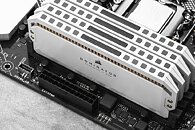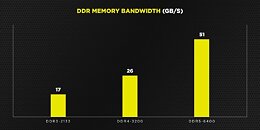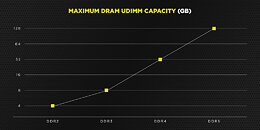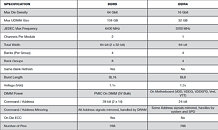- Joined
- Aug 19, 2017
- Messages
- 3,233 (1.12/day)
The fifth iteration of DDR technology, called DDR5, is set to arrive later this year. Many makers of DDR4 technology are announcing their plans to switch to the new standard, and CORSAIR is no exception. Known as the maker of high-quality products, CORSAIR has today posted a blog post teasing company's upcoming DDR5 products, and what they will be bringing to the table. For starters, the company has posted data about DDR5 modules that run at 6400 MHz speed, which is assumed to be the speed of the CORSAIR DDR5 modules when they arrive. At such speed, the memory can achieve a bandwidth of 51 GB/s, which is almost double the 26 GB/s that DDR4-3200 MHz memory achieves.
Another point CORSAIR wrote about is the capacity of a single DIMM. With DDR4, the company has made DIMMs that are only up to 32 GB in capacity. However, with DDR5, CORSAIR plans to quadruple that and build a single DDR5 DIMM that has up to 128 GB of memory on it. Another big point was the power required to run the new technology. The DDR4 standard required 1.2 Volts for operation, while the JEDEC specification says that DDR5 needs just 1.1 Volts to run. This will result in a cooler operation of memory modules.



Of course, the DDR5 standard needs a new platform to run on. Currently, only Intel's Alder Lake-S platform will be DDR5-ready later this year, when the new standard becomes available for consumers. Additionally, CORSAIR has published more information about the benefits of the new standard, which you can see a part of below.
DDR4 vs DDR5 differences:

View at TechPowerUp Main Site
Another point CORSAIR wrote about is the capacity of a single DIMM. With DDR4, the company has made DIMMs that are only up to 32 GB in capacity. However, with DDR5, CORSAIR plans to quadruple that and build a single DDR5 DIMM that has up to 128 GB of memory on it. Another big point was the power required to run the new technology. The DDR4 standard required 1.2 Volts for operation, while the JEDEC specification says that DDR5 needs just 1.1 Volts to run. This will result in a cooler operation of memory modules.



Of course, the DDR5 standard needs a new platform to run on. Currently, only Intel's Alder Lake-S platform will be DDR5-ready later this year, when the new standard becomes available for consumers. Additionally, CORSAIR has published more information about the benefits of the new standard, which you can see a part of below.
CORSAIR said:FURTHER REFINEMENTS
With DDR5, individual modules are split into two separate channels by design, allowing for shorter traces that contribute to less latency and higher speeds when it comes to communicating with individual memory ICs on a memory module. This also allows for what's referred to as command/address mirroring since the signal from the CPU has to travel a shorter overall path to access specific banks of memory whereas in DDR4 a command/address signal had to travel through all banks of memory in a longer chain.
On DDR4, when a single bank of memory needed to be refreshed, the CPU had to wait for all banks of memory on a module to refresh before doing another read or write. With DDR5, we've got double the bank groups and when a bank needs to be refreshed only the same bank of each group is refreshed, allowing for the other memory bank groups to be accessed without the CPU having to wait.
Overall single access latency with DDR5 is relatively unchanged, while CAS Latency has increased, the overall latency of a top-tier DDR5 kit will be similar to previous generations of DRAM clocking in at 14-15ns thanks to the improvements we previously mentioned.
ON-DIE ECC
Reliability goes down as process technologies shrink, resulting in higher latency and looser timings overall at higher speeds. DDR5 features on-die ECC as part of its spec, helping to reduce errors and allow for memory ICs to operate at higher frequencies. To be clear, this doesn't mean that mainstream DDR5 is using a full-fledged ECC implementation, there'll still be unregistered modules for typical consumer applications and ECC modules for enterprise/research applications.
DDR4 vs DDR5 differences:

View at TechPowerUp Main Site




